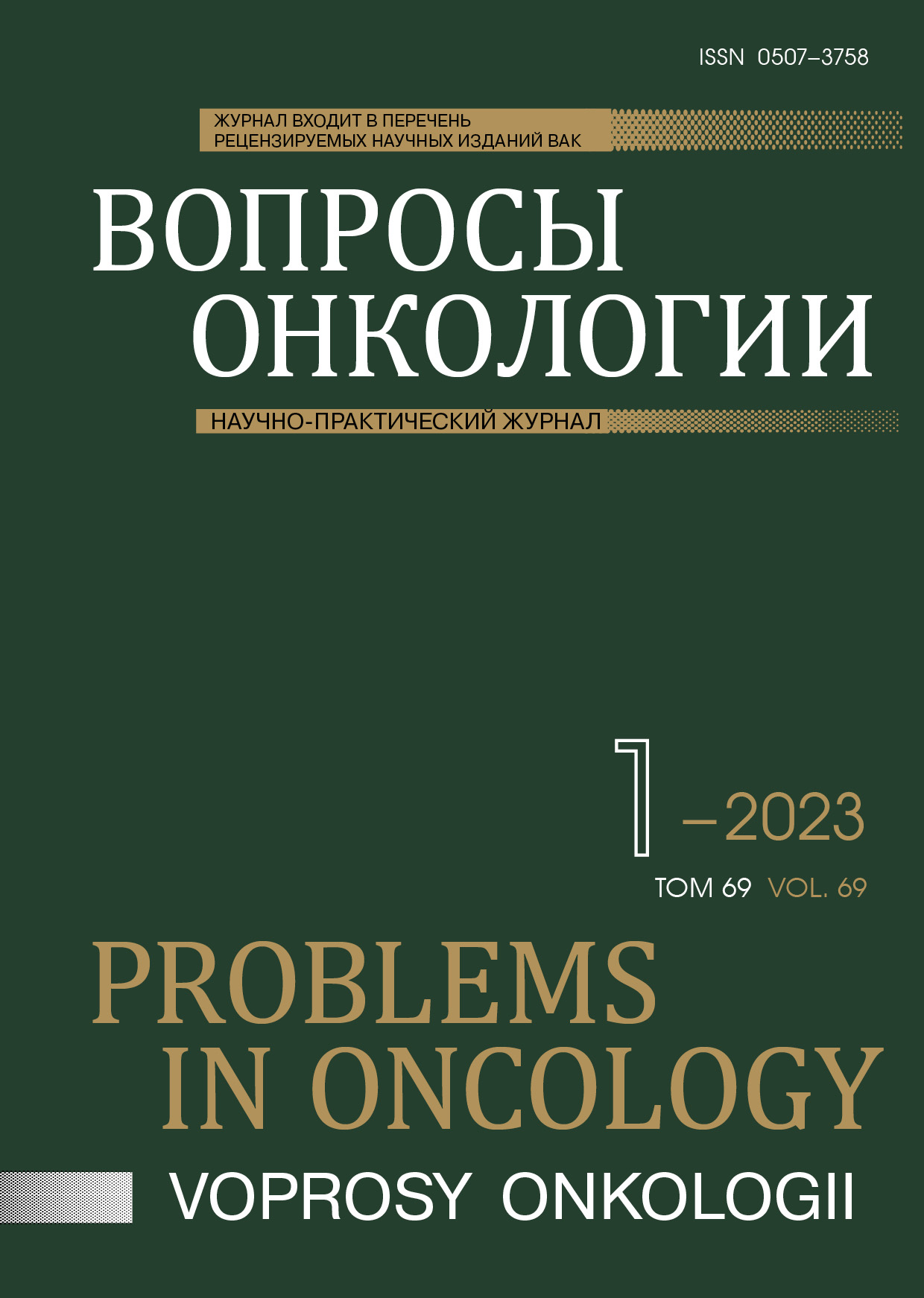Аннотация
Локальный рецидив после первичной лучевой терапии опухолей полости носа возникает у 18-40% пациентов в первые 5 лет от момента окончания лечения. Основной метод лечения рецидивов – хирургический, но в ситуации, когда хирургическое лечение по каким-то причинам провести невозможно, методами выбора остаются химио- и/или лучевая терапия. Радикальные дозы первичного лечения практически не оставляют резерва толерантности окружающих здоровых тканей, что выражается в повышении вероятности развития поздних лучевых осложнений. Протонная терапия за счет особенностей распределения дозы, позволяет уменьшить нагрузку на окружающие здоровые ткани, что потенциально должно привести к снижению количества поздних лучевых осложнений и улучшить переносимость лечения. В работе приведен собственный опыт применения протонной терапии в качестве методики повторного облучения у пациентки с рецидивом опухоли полости носа. Данным примером мы показали, что курс протонной терапии может быть успешно реализован в качестве метода повторного лечения у пациентов с рецидивами опухолей полости носа, одной из наиболее сложных локализаций с точки зрения дозиметрического планирования в лучевой терапии.
Библиографические ссылки
Cardesa A, Alos L, Nadal A, et al. Nasal Cavity and Paranasal Sinuses. Pathology of the Head and Neck. 2017:49-127. doi: 10.1007/978-3-662-49672-5_2.
Мудунов А.М., Чойнзонов Е.Л., Решетов И.В. и др. Рак ротоглотки: клинические рекомендации [Электронный ресурс]. Общероссийский национальный союз «Ассоциация онкологов России». Москва, 2020;62 [Mudunov AM, Choinzonov EL, Reshetov IV, et al. Clinical recommendations: Cancer of nasal cavity and paranasal sinuses. Association of Oncologists of Russia [Internet]. Moscow, 2020;62 (in Russ).]. Available from: https://old.oncology-association.ru/files/clinical-guidelines-2020/rak_rotoglotki.pdf.
Caudell JJ, Gillison ML, Maghami E, el al. NCCN Guidelines® insights: head and neck cancers, version 1.2022. J Natl Compr Canc Netw. 2022;20(3):224-234. doi:10.6004/JNCCN.2022.0016.
Kim SA, Chung YS, Lee BJ. Recurrence patterns of sinonasal cancers after a 5-year disease-free period. Laryngoscope. 2019;129(11):2451-2457. doi:10.1002/lary.27866.
Scurry WC Jr, Goldenberg D, Chee MY, et al. Regional recurrence of squamous cell carcinoma of the nasal cavity: a systematic review and meta-analysis. Arch Otolaryngol Head Neck Surg. 2007;133(8):796-800. doi:10.1001/archotol.133.8.796.
Wong SJ, Machtay M, Li Y. Locally recurrent, previously irradiated head and neck cancer: concurrent re-irradiation and chemotherapy, or chemotherapy alone? J.Clin.Oncol. 2006;24(17):2653–8. doi:10.1200/JCO.2005.05.3850.
Svajdova M, Dubinsky P, Kazda T. Radical external beam re-irradiation in the treatment of recurrent head and neck cancer: Critical review. Head Neck. 2021;43(1):354-366. doi:10.1002/hed.26485.
Kong L, Wang L, Shen C, et al. Salvage intensity-modulated radiation therapy (IMRT) for locally recurrent nasopharyngeal cancer after definitive IMRT: A Novel Scenario of the Modern Era. Sci Rep. 2016;6:32883. doi:10.1038/srep32883.
Yamazaki H, Ogita M, Kodani N, et al. Frequency, outcome and prognostic factors of carotid blowout syndrome after hypofractionated re-irradiation of head and neck cancer using CyberKnife: A multi-institutional study. Radiother. Oncol. 2013;107:305-309. doi:10.1016/j.radonc.2013.05.005.
Shuja M, Routman DM, Foote RL, et al. Clinical outcomes after re-irradiation in recurrent head and neck cancers treated with intensity modulated proton and photon therapies. Int J Radiat Oncol Biol Phys. 2019;105(1):E382-3. doi:10.1016/j.ijrobp.2019.06.1644.
Phan J, Sio TT, Nguyen TP, et al. Reirradiation of head and neck cancers with proton therapy: outcomes and analyses. Int J Radiat Oncol Biol Phys. 2016;96(1):30-41. doi:10.1016/j.ijrobp.2016.03.053.
McDonald MW, Zolali-Meybodi O, Lehnert SJ, et al. Reirradiation of recurrent and second primary head and neck cancer with proton therapy. Int J Radiat Oncol Biol Phys. 2016;96(4):808-819. doi:10.1016/j.ijrobp.2016.07.037.
Gordon K, Gulidov I, Semenov A, et al. Proton re-irradiation of unresectable recurrent head and neck cancers. Rep Pract Oncol Radiother. 2021 ;26(2):203-210. doi:10.21203/rs.3.rs-45989/v1.
Bentzen SM, Constine LS, Deasy JO, et al. Quantitative analyses of normal tissue effects in the clinic (QUANTEC): an introduction to the scientific issues. Int J Radiat Oncol Biol Phys. 2010;76 (3):S3-9. doi:10.1016/j.ijrobp.2009.09.040.
Ang KK, Price RE, Stephens LC, et al. The tolerance of the primate spinal cord to re-irradiation. Int J Radiat Oncol Biol Phys. 1993;25(3):459-464. doi:10.1016/0360-3016(93)90067-6.

Это произведение доступно по лицензии Creative Commons «Attribution-NonCommercial-NoDerivatives» («Атрибуция — Некоммерческое использование — Без производных произведений») 4.0 Всемирная.
© АННМО «Вопросы онкологии», Copyright (c) 2023

